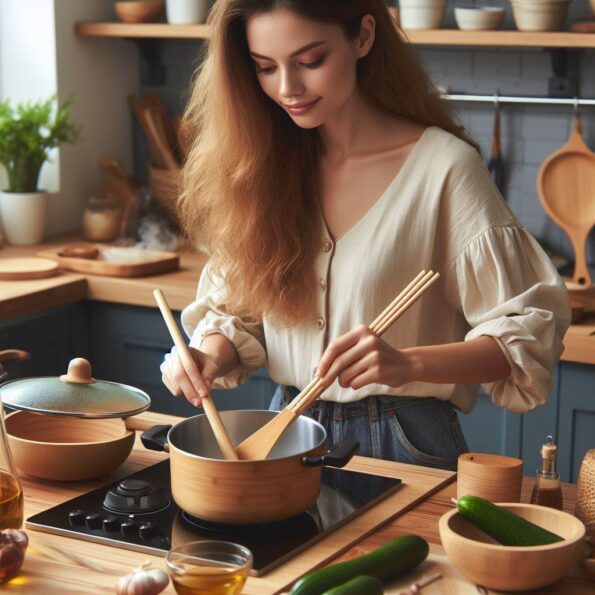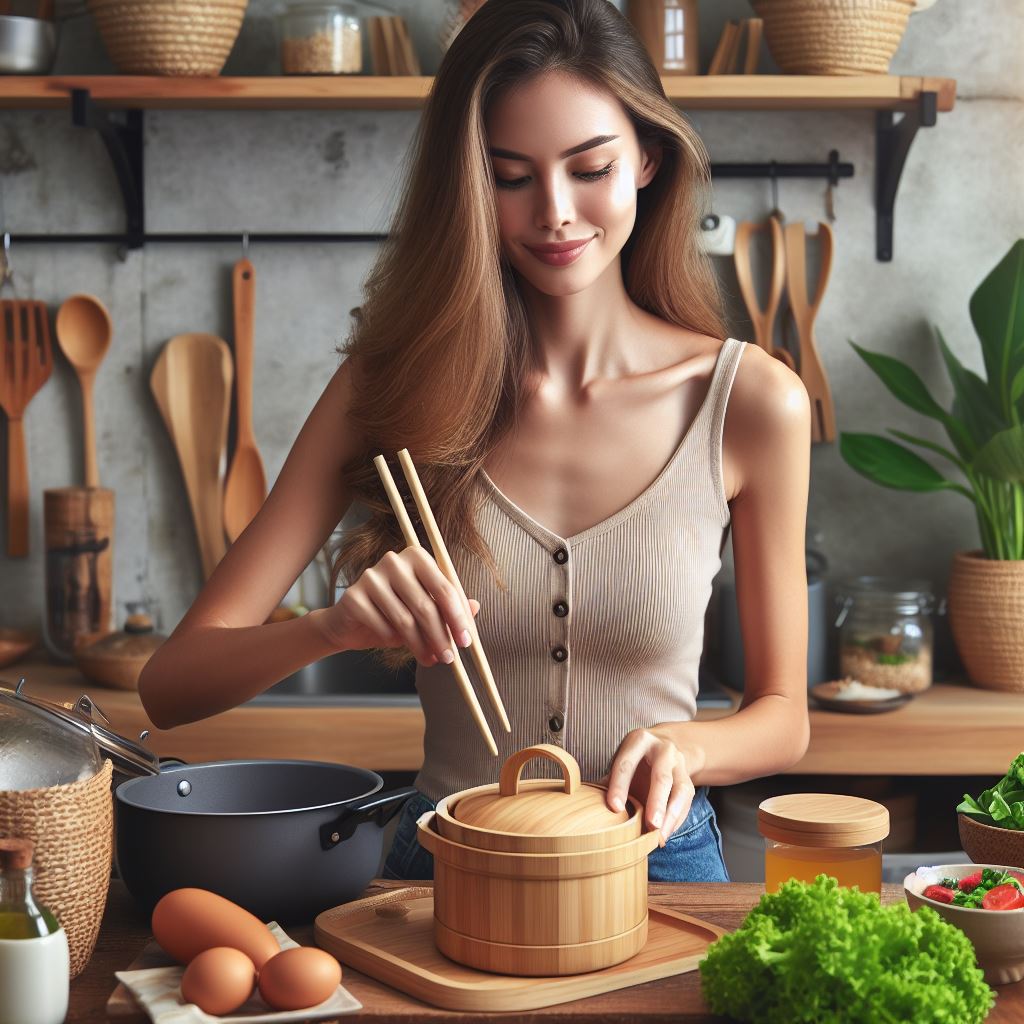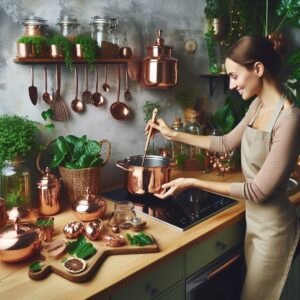Bamboo Kitchenware the journey towards sustainable living is gaining momentum, with more individuals and households adopting practices that reduce their environmental footprint. This shift is not just about energy efficiency or reducing waste; it’s about a holistic approach to life that respects our planet’s resources.
In the realm of modern kitchens, bamboo is becoming the go-to material, and for good reason.
Bamboo’s sustainability credentials are impressive:
- Rapidly Renewable: Bamboo can grow to full size in just 3-4 months, compared to decades for hardwood trees.
- Low Water and Pesticide Use: It requires minimal water and no pesticides, making it a more eco-friendly option.
- Carbon Sequestration: Bamboo absorbs more carbon dioxide and releases more oxygen compared to other plants.
- Soil Protection: Its strong roots prevent soil erosion and can be planted in areas prone to landslides.
These attributes make bamboo an ideal choice for kitchenware, from cutting boards to utensils, offering durability, aesthetic appeal, and a positive environmental impact. As we embrace eco-friendly cooking, bamboo stands out as a symbol of the sustainable choices we can make every day in our homes.
What are some other eco-friendly materials for kitchenware?
There are several eco-friendly materials that are great alternatives for kitchenware, offering sustainability and reduced environmental impact:
- Cast Iron: Known for its durability and heat retention, cast iron is a long-lasting choice that can often be made from recycled materials.
- Stainless Steel: Resistant to rust and corrosion, stainless steel kitchenware is durable and recyclable, making it an eco-friendly option.
- Ceramic: Ceramics are made from natural clay and offer a non-reactive and often non-stick surface without the harmful chemicals found in traditional non-stick coatings.
- Glass: Fully recyclable and non-toxic, glass is an inert material that doesn’t leach chemicals into food and is ideal for storage and baking.
- Bamboo: As previously discussed, bamboo is a rapidly renewable resource that is biodegradable and has a minimal environmental footprint.
Bamboo 101: Understanding the Material of the Moment
Bamboo is not only a symbol of tranquility and natural beauty but also a powerhouse of sustainability. Here’s a brief overview of its growth, harvesting, and environmental advantages:
The Growth and Harvesting of Bamboo:
- Bamboo is one of the fastest-growing plants on Earth, with some species capable of growing up to 91 cm (36 in.) in a 24-hour period.
- It reaches maturity and can be harvested within 3 to 7 years, which is significantly quicker than hardwood trees that can take decades.
- Harvesting bamboo is a delicate process that requires timing; it’s usually done after the rainy season when the starch content is lowest to prevent pest infestations.
Bamboo’s Environmental Edge:
- Bamboo has a remarkable growth rate and can be harvested without killing the plant, making it a highly renewable resource.
- It absorbs more carbon dioxide and releases more oxygen compared to equivalent masses of trees, which makes it a champion in mitigating climate change.
- Unlike traditional crops, bamboo requires less water, herbicides, and fertilizers to grow, making it a low-impact crop.

The Benefits of Bamboo in the Kitchen
Bamboo offers a multitude of benefits for kitchen use, making it a popular choice for those seeking sustainable and practical options:
- Eco-Friendliness: Bamboo is a highly sustainable and renewable resource, which helps reduce the demand for traditional wood sources. It grows rapidly and is ready for harvesting in just a few years, minimizing the environmental impact caused by deforestation.
- Durability and Longevity: Bamboo kitchen utensils are not only eco-friendly but also tougher than traditional wooden or plastic ones. They offer a unique combination of strength and lightness, ideal for everyday cooking tasks.
- Safety Features: Bamboo possesses natural antimicrobial properties that inhibit the growth of bacteria on its surface, making it a safe choice for food preparation. It’s free from toxic substances often found in synthetic materials.
- Versatility: Bamboo utensils come in various sizes and shapes, suitable for cooking, serving, and even enhancing the aesthetics of your kitchen. They’re lightweight, which is beneficial for those with mobility issues or arthritis.
- Economic Benefits: Investing in bamboo utensils can be economical as they offer longevity and quality at an affordable price point, reducing the need for frequent replacements.
- Aesthetic Appeal: The natural beauty of bamboo utensils can elevate the visual appeal of your kitchen, contributing to a sustainable lifestyle while adding a warm, natural feel to your home’s decor.
From Pots to Spoons: The Versatility of Bamboo Kitchenware
Bamboo kitchenware is celebrated for its versatility, offering a range of products that cater to various culinary needs. From the durability required for chopping and slicing on bamboo cutting boards to the elegance of serving hors d’oeuvres on bamboo trays, this material proves to be as functional as it is stylish. The natural resistance of bamboo to heat, stains, and odors ensures that kitchenware made from this material maintains its pristine condition, even when used with the most colorful foods and spices.
Moreover, the array of utensils available in bamboo is extensive. You can find spoons, forks, knives, spatulas, tongs, and salad servers, all designed to withstand the rigors of everyday cooking while being gentle on cookware surfaces. This adaptability makes bamboo kitchenware a suitable addition to any kitchen, aligning with the growing trend towards sustainable living without compromising on quality or aesthetics. Whether you’re cooking a family meal or entertaining guests, bamboo kitchenware is an excellent choice for those who value both functionality and environmental responsibility.
The Aesthetic Appeal of Bamboo
Bamboo’s aesthetic appeal lies in its natural elegance and versatility, which has made it a favored material in design and architecture. Its unique texture and grain patterns bring a sense of calm and simplicity to spaces, while its strength and flexibility allow for a wide range of creative applications. From furniture to flooring and decorative elements, bamboo adds a warm, organic touch to interiors, blending seamlessly with various decor styles. Its sustainable nature further enhances its appeal, offering a choice that is both environmentally conscious and visually captivating.
Caring for Your Bamboo Kitchenware: Tips and Tricks
Caring for bamboo kitchenware is essential to maintain its beauty and longevity. Here are some tips and tricks to keep your bamboo items in top condition:
- Hand Wash: Always hand wash your bamboo utensils with mild soap and warm water. Avoid using harsh detergents or scrubbers that can damage the surface.
- Dry Thoroughly: After washing, dry your bamboo items with a towel or let them air dry completely before storing. This prevents mold growth and maintains the integrity of the bamboo.
- Oil Regularly: Periodically apply a food-safe oil, like mineral oil or bamboo oil, to your utensils. This helps to moisturize the bamboo and keep it from cracking or drying out.
- Avoid Soaking: Don’t leave your bamboo kitchenware to soak in water, as prolonged exposure to moisture can cause warping or discoloration.
- Store Properly: Once dry, store your bamboo items in a cool, dry place. If you live in a particularly humid climate, consider storing them in an area with good air circulation to avoid moisture buildup.
Conclusion:
As we navigate towards a more sustainable future, bamboo stands out as a beacon of eco-friendliness and versatility. Its rapid growth, ability to regenerate without replanting, and impressive carbon sequestration capabilities make it a prime candidate for a wide array of uses, from construction to textiles, and of course, kitchenware.
The future of bamboo is bright, with its potential to significantly contribute to sustainable living practices. It’s not just about replacing plastic with bamboo; it’s about embracing a material that grows with minimal environmental impact and offers a multitude of benefits. As consumers become more environmentally conscious, the demand for bamboo-based products is likely to increase, further driving innovation and sustainability in various industries.
In conclusion, bamboo’s role in sustainable living is more than a trend—it’s a shift in how we view and use resources. It represents a harmonious balance between meeting human needs and preserving the environment, making it a symbol of hope and progress in our collective journey towards a greener planet. Choosing bamboo kitchenware is a step towards a more sustainable and eco-friendly kitchen. For more tips on sustainable living, visit The Amrit Life.











